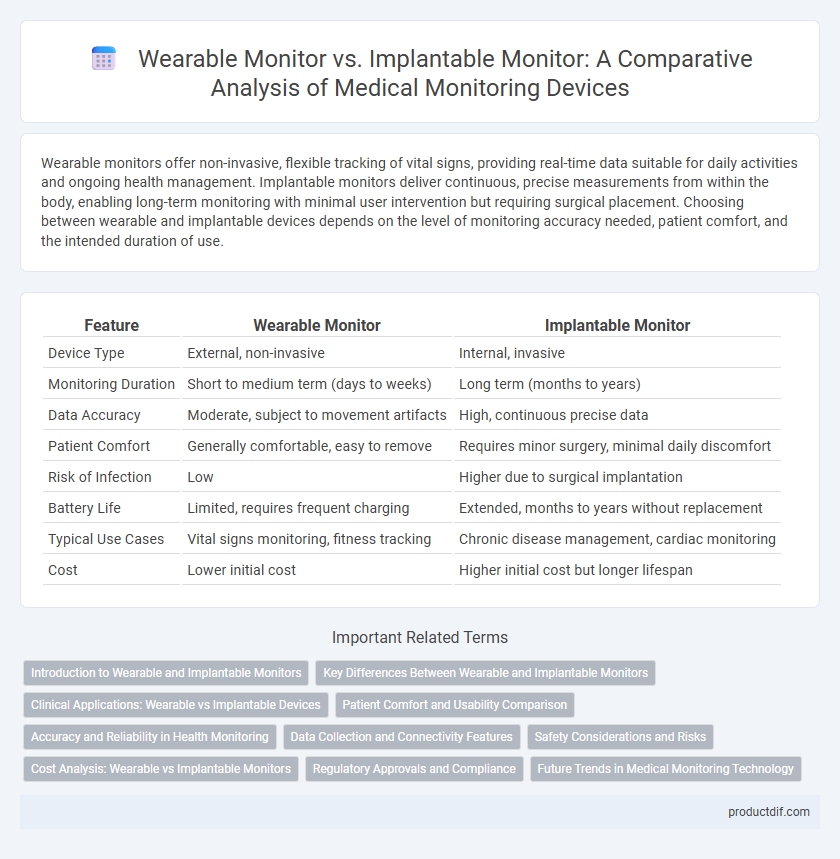Wearable monitors offer non-invasive, flexible tracking of vital signs, providing real-time data suitable for daily activities and ongoing health management. Implantable monitors deliver continuous, precise measurements from within the body, enabling long-term monitoring with minimal user intervention but requiring surgical placement. Choosing between wearable and implantable devices depends on the level of monitoring accuracy needed, patient comfort, and the intended duration of use.
Table of Comparison
| Feature | Wearable Monitor | Implantable Monitor |
|---|---|---|
| Device Type | External, non-invasive | Internal, invasive |
| Monitoring Duration | Short to medium term (days to weeks) | Long term (months to years) |
| Data Accuracy | Moderate, subject to movement artifacts | High, continuous precise data |
| Patient Comfort | Generally comfortable, easy to remove | Requires minor surgery, minimal daily discomfort |
| Risk of Infection | Low | Higher due to surgical implantation |
| Battery Life | Limited, requires frequent charging | Extended, months to years without replacement |
| Typical Use Cases | Vital signs monitoring, fitness tracking | Chronic disease management, cardiac monitoring |
| Cost | Lower initial cost | Higher initial cost but longer lifespan |
Introduction to Wearable and Implantable Monitors
Wearable monitors are non-invasive medical devices designed to continuously track vital signs such as heart rate, oxygen saturation, and activity levels through sensors worn on the body. Implantable monitors are surgically inserted devices that provide long-term, precise monitoring of physiological parameters like intracardiac pressures or glucose levels, offering real-time data critical for chronic disease management. Both technologies enhance patient care by enabling remote monitoring and early detection of health issues, tailored to varying clinical needs.
Key Differences Between Wearable and Implantable Monitors
Wearable monitors offer non-invasive, external tracking of vital signs with easy removal and adjustment, while implantable monitors provide continuous, internal measurement with higher accuracy for long-term health data. Wearable devices rely on external sensors and wireless connectivity, making them suitable for short-term monitoring and patient convenience. Implantable monitors, however, require surgical placement but deliver more reliable data for chronic conditions by minimizing external interference and ensuring consistent physiological monitoring.
Clinical Applications: Wearable vs Implantable Devices
Wearable monitors offer non-invasive, continuous tracking of vital signs such as heart rate, oxygen saturation, and activity levels, making them ideal for outpatient monitoring and early disease detection. Implantable monitors provide precise, long-term data on cardiac rhythms, intracranial pressure, or neurostimulation, essential for managing chronic conditions like arrhythmias or epilepsy. Clinical applications favor wearable devices for convenience and patient compliance, while implantable monitors are preferred when accurate, real-time internal physiological data is critical for treatment decisions.
Patient Comfort and Usability Comparison
Wearable monitors offer superior patient comfort due to their non-invasive design, allowing easy removal and minimal skin irritation, while implantable monitors provide continuous, real-time data but may cause discomfort during and after surgery. Usability in wearable devices is enhanced by wireless connectivity and user-friendly interfaces, whereas implantable monitors require professional insertion and periodic maintenance, limiting patient control. The choice between these devices often depends on balancing long-term monitoring needs with patient lifestyle and comfort preferences.
Accuracy and Reliability in Health Monitoring
Wearable monitors provide non-invasive health tracking with moderate accuracy, often influenced by external factors like movement and sensor placement. Implantable monitors offer higher reliability and precise, continuous data by measuring physiological parameters directly within the body, reducing signal interference. Both devices support health monitoring, but implantable systems excel in long-term accuracy for critical conditions.
Data Collection and Connectivity Features
Wearable monitors offer non-invasive, continuous data collection with real-time wireless connectivity through Bluetooth or Wi-Fi, enabling seamless remote patient monitoring and data synchronization with mobile apps and cloud platforms. Implantable monitors provide highly accurate, long-term physiological data by directly measuring internal body conditions, often featuring advanced biocompatible sensors and telemetry systems for secure, real-time transmission to healthcare providers. Both devices utilize sophisticated algorithms for data analysis, but implantable monitors excel in providing precise, continuous insights for chronic condition management.
Safety Considerations and Risks
Wearable monitors offer non-invasive safety with minimal risk of infection or device-related complications, making them suitable for continuous outpatient monitoring. Implantable monitors, while providing more accurate and reliable data through direct physiological measurements, carry higher risks such as surgical complications, device migration, and potential biofouling. Careful evaluation of patient condition and device-specific safety profiles is essential to mitigate adverse events associated with implantable medical devices.
Cost Analysis: Wearable vs Implantable Monitors
Wearable monitors generally have a lower initial cost compared to implantable monitors, which require surgical procedures and postoperative care, significantly increasing overall expenses. Maintenance and replacement costs for implantable monitors are higher due to device longevity and potential complications, whereas wearable monitors offer more affordable upgrades and ease of use. Cost-effectiveness analysis often favors wearable monitors for short-term monitoring, while implantable devices may be justified for long-term chronic condition management despite their higher upfront and maintenance costs.
Regulatory Approvals and Compliance
Wearable monitors typically undergo FDA clearance under the Class II medical device category, requiring adherence to standards such as ISO 13485 and compliance with the Medical Device Reporting (MDR) regulations for post-market surveillance. Implantable monitors face more stringent regulatory scrutiny, often classified as Class III devices due to their invasive nature, necessitating Premarket Approval (PMA) submissions and rigorous clinical trial data to demonstrate safety and efficacy. Both device types must comply with international regulations such as the EU Medical Device Regulation (MDR 2017/745) and undergo continuous quality management system audits to ensure ongoing compliance.
Future Trends in Medical Monitoring Technology
Wearable monitors are rapidly advancing with improved sensor accuracy, longer battery life, and enhanced wireless connectivity, making them more accessible for continuous patient monitoring outside clinical settings. Implantable monitors are evolving toward miniaturization, biocompatible materials, and real-time data transmission, enabling precise long-term health tracking and early detection of medical conditions. The integration of artificial intelligence and machine learning in both wearable and implantable devices is driving personalized medicine and proactive healthcare management.
Wearable monitor vs Implantable monitor Infographic

 productdif.com
productdif.com